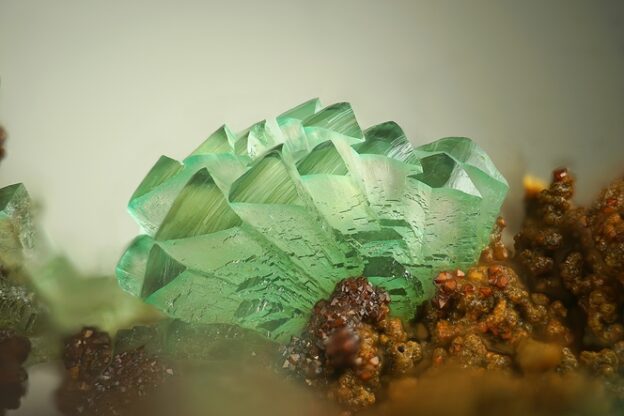Fortunately, neither humans nor any other creatures feed on adamites. Therefore, there is no need to escape from arsenic poisoning after episodic communication with a beautiful and rare stone. Yes, and jewelry with adamites and adamites on the shelves of jewelry stores cannot be found, although in some cases the stone is cut and set in silver.
Adamite’s story
French mineralogist Gilbert-Joseph Adam, who worked in the 19th century, described adamite from samples brought from South America. The first specimens of the beautiful yellow stone were found in the Chilean Atacama Desert, on the territory of the Gagnarsillo ore deposit.
The find took place in 1866. Later, the Adamites were found in Mexico, Greece, and France. Today, the Adamites are appreciated from Turkey and especially from Africa, from the vicinity of the Namibian city of Tsumeb. In Russia, adamite is found in the Far East, in Transbaikalia, near Nizhny Tagil.
Adamite crystals on limonite
Long known to the American Indians, adamite was used in shamanic rituals. The person doomed to be sacrificed was decorated with adamite beads, and a larger bead was put in his mouth. The swallowed stone dissolved in the stomach of the unfortunate person, guaranteeing the inevitable transition to the spirit world.
Properties of adamite
Adamite (adamin in the Russian mineralogical tradition) is rare, fragile and unstable. The hardness of the gem does not exceed 3.5 points on the Mohs scale. Crystals of adamite usually do not even reach 10 mm in length, although in some deposits there are beautiful intergrowths up to 2.5 cm in size. Mexican adamites from the state of Durango are especially large and sometimes grow up to 12 centimeters in length.
Micro cluster of adamite crystals, France. Macro shooting.
Adamite is extremely fragile and prone to cracking even without mechanical stress.
In nature, adamite is rare. Zinc arsenate crystals most readily grow on a limonite or calcite substrate, while adamite forms geodes and druses in natural cavities and cracks. The thin initial adamite crust is covered with crystalline grains, after which the growth of well-formed crystals of the mineral is sometimes observed.
Yellow and green crystals of adamite have a characteristic prismatic shape, but can be acicular or tabular. In ultraviolet light, adamite crystals, not too contaminated with impurities, fluoresce with a lemon-tone glow.
The stone dissolves easily in acidic solutions. The products of the dissociation of zinc arsenate, which is adamite, are extremely toxic – so the Indian priests were not mistaken, considering the swallowed adamite the right ticket to the land of their ancestors.
The chemical formula of the mineral is Zn2 (AsO4) (OH). The OH hydroxyl group attached to the zinc-arsenic oxide compound is easily removed by heating. Dehydration causes spontaneous cracking, discoloration and loss of clarity of the mineral.
Colored adamite
Natural color of adamite is bright, juicy shades of yellow, yellowish-brown and yellow-green colors. There are, however, and colorless, and pinkish, and purple, and brownish adamites of uneven color. The abundance of copper, partially or completely replacing zinc atoms in the molecule of the substance, makes adamite bright green with a slight blue tint, but weakens the characteristic glass luster.
Green adamite crystal
Copper-containing, but not devoid of zinc, adamite is called cuproadamite. If the zinc in adamite is completely replaced by copper, the mineral becomes emerald-green olivienite, and its crystals sometimes grow in needle-like brushes, reminiscent of sea urchins.
Cobaltoadamite (especially with a small admixture of manganese) is beautiful with smooth color transitions from pink to lilac, lilac and violet. The admixed iron makes additional adjustments to the color characteristics of adamite.
Using adamite
In the jewelry industry, adamite is not used due to its minimal hardness, pronounced fragility and a tendency to spontaneous destruction when dried and heated. However, individual craftsmen take the risk of converting the flashy mineral into jewelry. Lilac Namibian adamites are faceted, yellow Mexican stones are turned into cabochons.
The aggregate of accreted adamite crystals is greenish yellow. Spheroid shape.
The product is created in such a way that to exclude direct contact of the adamite insert with the body. Such a measure is sufficient to eliminate the negative impact of arsenic compounds on human health. However, in most cases, faceted adamites (the known maximum weight is three carats) enter mineralogical collections.
Collectible specimens of adamite are famous for their exceptional expressiveness and are in constant demand among lovers of natural rarities.
Faceted Adamite – faceted.
Home-grown lithotherapists readily recommend the use of adamite to treat skin diseases. However, adamite applications and other contact procedures, with excessive zeal, can be harmful: arsenic is destructive to the cells of the body.
To completely eliminate the danger, jewelry adamites are recommended to be stored in separate boxes. Collectible adamites should be kept under glass.

